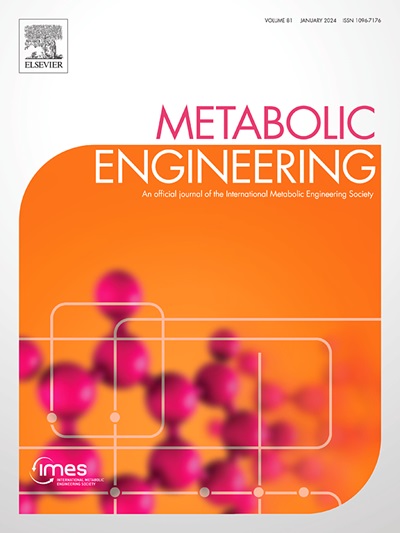通过蛋白质和代谢工程建立香豆素生产平台。
IF 6.8
1区 生物学
Q1 BIOTECHNOLOGY & APPLIED MICROBIOLOGY
引用次数: 0
摘要
香豆素是一个庞大的天然产品家族,具有多种生物活性。肉桂酰-CoA 原羟化酶(CCHs)催化香豆素生物合成的关键和限速步骤。然而,由于底物体积大且结构-活性关系模糊,CCHs 的工程化具有挑战性。本文采用基于荧光的筛选方法,通过定向进化和结构引导工程来设计一种 CCH(拟南芥中的 AtF6'H),从而获得了具有更高活性的可移植表面突变和底物特异性口袋突变。结构分析和分子动力学模拟阐明了导致催化效率提高的构象变化。应用经过优化的上游生物合成途径的适当变体,可使三种简单香豆素的滴度提高 5-22 倍。进一步引入糖基化模块后,生产出了四种香豆素葡萄糖苷,其中香豆素的滴度提高了 15.7 倍,在放大发酵中达到了 3 克/升。这项工作释放了 CCHs 的潜力,并建立了香豆素生产的大肠杆菌平台。本文章由计算机程序翻译,如有差异,请以英文原文为准。
Establishing a coumarin production platform by protein and metabolic engineering
Coumarins are a vast family of natural products with diverse biological activities. Cinnamyl-CoA ortho-hydroxylases (CCHs) catalyze the gateway and rate-limiting step in coumarin biosynthesis. However, engineering CCHs is challenging due to the large size of the substrates and the vague structure-activity relationship. Herein, directed evolution and structure-guided engineering were performed to engineer a CCH (AtF6′H from Arabidopsis thaliana) using a fluorescence-based screening method, yielding the transplantable surface mutations and the substrate-specific pocket mutations with improved activity. Structural analysis and molecular dynamics simulations elucidated the conformational changes that led to increased catalytic efficiency. Applying appropriate variants with the optimized upstream biosynthetic pathways improved the titers of three simple coumarins by 5 to 22-fold. Further introducing glycosylation modules resulted in the production of four coumarin glucosides, among which the titer of aesculin was increased by 15.7-fold and reached 3 g/L in scale-up fermentation. This work unleashed the potential of CCHs and established an Escherichia coli platform for coumarins production.
求助全文
通过发布文献求助,成功后即可免费获取论文全文。
去求助
来源期刊

Metabolic engineering
工程技术-生物工程与应用微生物
CiteScore
15.60
自引率
6.00%
发文量
140
审稿时长
44 days
期刊介绍:
Metabolic Engineering (MBE) is a journal that focuses on publishing original research papers on the directed modulation of metabolic pathways for metabolite overproduction or the enhancement of cellular properties. It welcomes papers that describe the engineering of native pathways and the synthesis of heterologous pathways to convert microorganisms into microbial cell factories. The journal covers experimental, computational, and modeling approaches for understanding metabolic pathways and manipulating them through genetic, media, or environmental means. Effective exploration of metabolic pathways necessitates the use of molecular biology and biochemistry methods, as well as engineering techniques for modeling and data analysis. MBE serves as a platform for interdisciplinary research in fields such as biochemistry, molecular biology, applied microbiology, cellular physiology, cellular nutrition in health and disease, and biochemical engineering. The journal publishes various types of papers, including original research papers and review papers. It is indexed and abstracted in databases such as Scopus, Embase, EMBiology, Current Contents - Life Sciences and Clinical Medicine, Science Citation Index, PubMed/Medline, CAS and Biotechnology Citation Index.
 求助内容:
求助内容: 应助结果提醒方式:
应助结果提醒方式:


